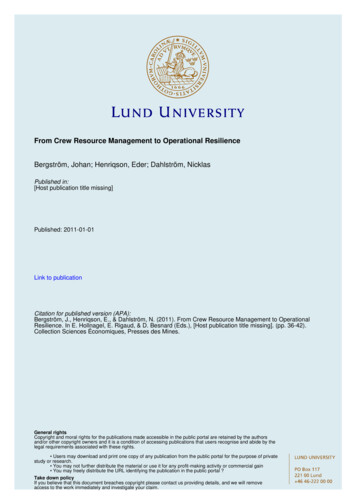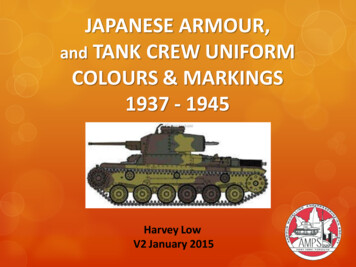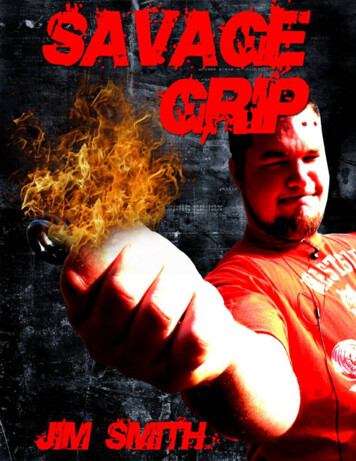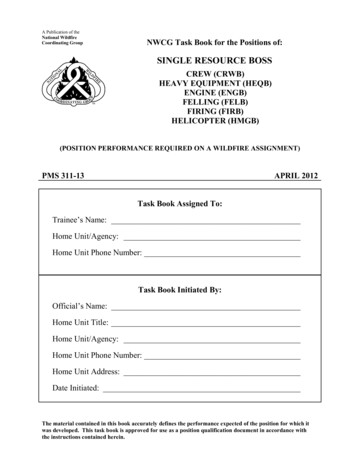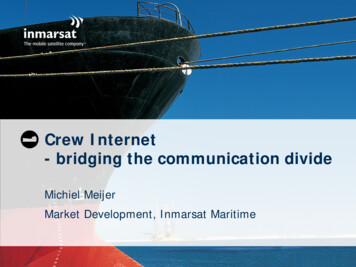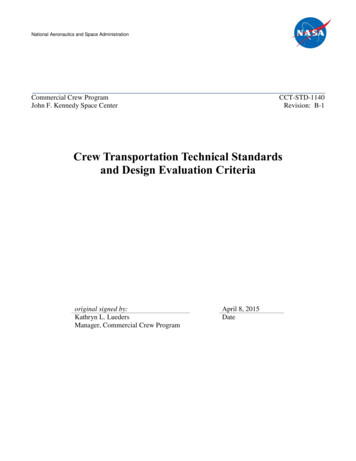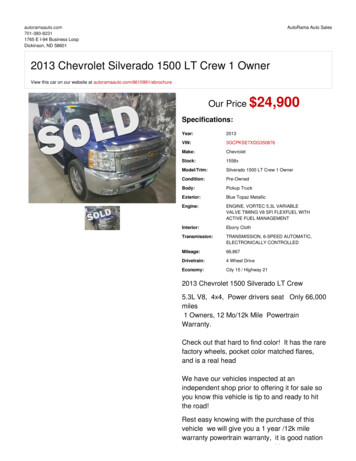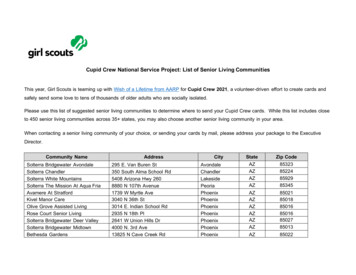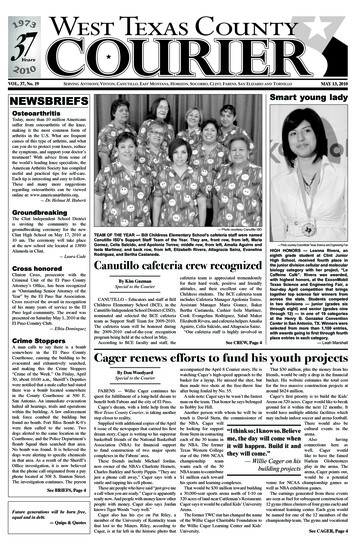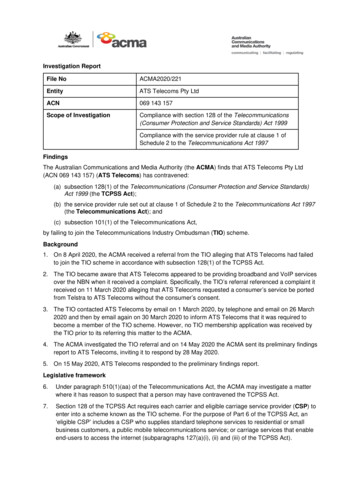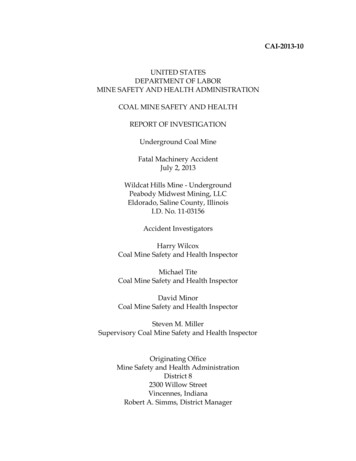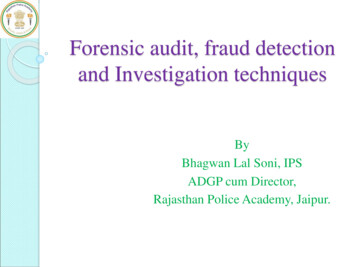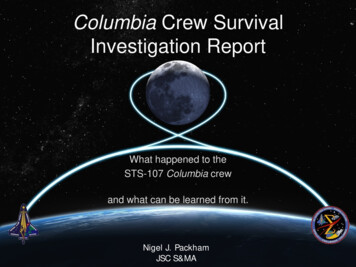
Transcription
Columbia Crew SurvivalInvestigation ReportWhat happened to theSTS-107 Columbia crewand what can be learned from it.Nigel J. PackhamJSC S&MA
199020102000SoyuzRussiaMirISSApollo 13Soyuz 11ChallengerColumbiaSoyuz 1ApolloFireBondarenkoTest1950- loss of life2010196119671969 197019862003- close callFSO Significant Events Overview Graphic – Loss of Life (Build)
NoticeThe presenter’s extended involvement inthis investigation has resulted in a certain“comfort” with the subject matter. Thiscomfort should not be interpreted as beingcold or unprofessional, nor as a lack ofrespect for the Columbia crew or theirfamilies; it only reflects the fact thatextensive time with and exposure to thematerial has enabled coping with thistragedy and its outcome.SCSIIT Page 3
Purpose of this briefing Summarize the investigation activities, keyfindings and recommendations–Discuss how recommendations are beingaddressed by Shuttle and OrionNASA/SP-2008-565, Columbia Crew SurvivalInvestigation Report is available on-line athttp://www.nasa.gov/reportsSCSIIT Page 4
Agenda BackgroundMethodsAccident TimelineKey Findings/RecommendationsSCSIIT Page 5
Background
STS-107 History113th flight in the Shuttle Program28th flight of OV-102 Columbia16 day missionLaunch: Jan 16, 200315:39 GMT (9:39 am CST)81.7 seconds into flight, a piece of insulating foamseparated from the ET and struck the orbiter’s left wingDe-orbit burn: Feb. 1, 2003, 13:15 GMT (7:15 am CST)Entry Interface ( 400k ft, Mach 24.5) occurred at 13:44:09 GMTJan 16, 2003Planned touchdown was 14:15 GMT (8:15 am CST)SCSIIT Page 7Feb 1, 2003
Investigation Background Columbia Accident Investigation Board(CAIB) chartered in Feb 2003– A Crew Survival Working Group (CSWG) wasformed to investigate the Columbia accidentsurvival gap The group developed a top-level scenario for whathappened to the crew module Lack of funding limited the investigation, and no reportwas published except for what the CAIB put into theirreportSCSIIT Page 8
Investigation Background(cont.) CAIB report published in August 2003– CAIB report Observation 010.2-1 “Futurecrewed-vehicle requirements should incorporatethe knowledge gained from the Challenger andColumbia accidents in assessing the feasibility ofvehicles that could ensure crew survival even ifthe vehicle is destroyed.” Spacecraft Crew Survival IntegratedInvestigation Team (SCSIIT) chartered inOctober 2004SCSIIT Page 9
Investigation Background(cont.) SCSIIT Purpose: Form a multi-disciplinary team(engineering, life sciences, crew equipment, crewtraining, etc) to learn everything possible from theseevents to improve both current and future crew survival– Correlate structural/mechanical/thermal engineering withforensic pathology findings for both Challenger and Columbia– Generate a report with specific recommendations for theenhancement of current vehicles and the future designs ofmanned space vehicles and crew safety equipment, andestablish a comprehensive body of information for future efforts– Develop “lessons-learned” for investigations and for futurespacecraft design engineers, physicians supporting mannedspace flight, and NASA managers.SCSIIT Page 10
Methods
Methods To understand the environment the crewexperienced, investigators need to look at theaccelerations, thermal, and atmospheric aspectsof the accident. Several sources of data are needed for buildingan integrated story – video, debris, vehicletelemetry, medical, modeling/ simulationSCSIIT Page 12
Methods (cont.) Video anchored key events– Loss of Control– Vehicle breakup– Forebody breakupSCSIIT Page 13
Methods (cont.) Debris analysis proved to be immenselycomplicated– Easy to develop a false scenario from one or twopieces of debris– Best for broad assessments fire? directional loading? thermal events?SCSIIT Page 14
Methods (cont.) Thermal and loads are inter-related due to the trajectory,and are driven by ballistic number– Report includes a “Ballistics Tutorial”– Trajectory (translation) models can also provide thermalexposure estimates Key point to understand is the ballistic number– Difficult to determine ballistic number for complex shapes– Ballistics analysis cannot account for cascadingfailures/intermediate configurationsSCSIIT Page 15
Methods (cont.) Aerodynamic models were used to analyze forebodyattitude– Necessary in determining crew accelerations from highlydirectional (and constantly changing) deceleration loads This analysis was difficult– Aerodynamic model of forebody did not exist– Results were highly dependent on initial conditions– Aerodynamic properties in hypersonic regime not fullyunderstoodSCSIIT Page 16
Methods (cont.) Attempted to develop the cabin depressurizationtimeline from both angles– What did medical data indicate Literature search of past depress accidents– What did debris indicate Structural debris – middeck floor Debris cluster analysis of crew module structure vs. crew equipment Depressurization tests on drink bags and hygiene packages– Boundary driven – “not greater than,” “no earlierthan,” etcSCSIIT Page 17
Methods Areas that were extraordinarily hard:– Materials in a high temp., low pressure, monatomicoxygen (highly reactive) environment– Hypersonic separation dynamics Suit failure – Why? How? Seat Separation Shock wave impingement/shock-shock interaction– Emotional impact of analyzing the final moments ofthe crew’s livesSCSIIT Page 18
Accident Timeline
Accident Timeline (cont.) 13:44:09 Greenwich Mean Time (GMT) (7:44:09 am Central)- Entry Interface ( 400,000’, Mach 24.5) 13:58:40 – Backup Flight Software (BFS) Fault Messageswere annunciated on board: left inboard tire pressure readinggoes off scale lowSCSIIT Page 20
Accident Timeline (cont.) 13:44:09 Greenwich Mean Time (GMT) (7:44:09 am Central) Entry Interface ( 400,000’, Mach 24.5) 13:58:40 – Backup Flight Software (BFS) Fault Messages wereannunciated on board, left inboard tire pressure reading goes offscale low 13:59:32 – Loss Of Signal (LOS) - loss of real time telemetry datain the MCCSCSIIT Page 21
Accident Timeline (cont.) 13:44:09 Greenwich Mean Time (GMT) - Entry Interface( 400,000’, Mach 24.5) 13:58:40 – Backup Flight Software (BFS) Fault Messages wereannunciated on board, left inboard tire pressure reading goes offscale low 13:59:32 – Loss Of Signal (LOS) - loss of real time telemetry datain the MCC 13:59:32 - 13:59:37 - Reconstructed General Purpose Computer(RGPC1) data indicate systems nominal, increase to 4 yaw jets &bank angle to try to eliminate yaw error & rateSCSIIT Page 22
Accident Timeline (cont.) 13:44:09 Greenwich Mean Time (GMT) - Entry Interface( 400,000’, Mach 24.5) 13:58:40 – Backup Flight Software (BFS) Fault Messages wereannunciated on board, left inboard tire pressure reading goes offscale low 13:59:32 – Loss Of Signal (LOS) - loss of real time telemetry datain the MCC 13:59:32 - 13:59:37 - Reconstructed General Purpose Computer(RGPC1) data indicate systems nominal, increase to 4 yaw jets &bank angle to try to eliminate yaw error & rate 13:59:37 - Start of vehicle Loss of Control (LOC), based on RollRef alarm at 13:59:46– Vehicle dynamics were within human tolerance (probably no injuries,but probably disorienting)SCSIIT Page 23
13:59:37 – 13:59:46LOC Sim VideoCDR POV Sim VideoSCSIIT Page 24
0.500.0059:37X(g's) -1.0000:20Seat-1.501.000.50Y (g's) 0:1200:1600:2059:4159:4659:5059:54SCSIIT59:59 00Z (g's)1.501.000.500.0059:37Time (s)
Accident Timeline (cont.) 14:00:03 - 14:00:05 – RGPC2 data indicate cabin parameterswere normal, auxiliary power units (APUs) were running buthydraulic pressures and quantities were zero– Panel R2 APU switchesSCSIIT Page 26
Accident Timeline (cont.) 14:00:03 - 14:00:05 –RGPC2 data indicate cabin parameterswere normal, auxiliary power units (APUs) were running buthydraulic pressures and quantities were zero– Panel R2 APU switches 14:00:18 – Main vehicle break-up, or “Catastrophic Event”(CE), based on video & Operational/ Experimental (OEX)recorder power loss– Forebody separation was due to starboard payload bay sill failure(thermal), and the starboard X-link pulled through the 582 ringframe. The forebody yawed left and pitched down, and the portX-link failed at the 582. The crew module shifted inside theforward fuselage, causing impacts & probable breaches (Vol. Edamaged from below)SCSIIT Page 27
Yaw leftPitch downSCSIIT Page 28Orbiter Struc 101
CM shift inside FFLOC-CE Quad VideoCE VideoSCSIIT Page 29
Accident Timeline (cont.) 14:00:03 - 14:00:05 – Reconstructed General PurposeComputer (RGPC) data indicate cabin parameters werenormal, auxiliary power units (APUs) were running buthydraulic pressures and quantities were zero– Panel R2 APU switches 14:00:18 – Main vehicle break-up, or “Catastrophic Event”(CE), based on video & OEX recorder power loss– Medical evidence indicates that the cabin pressure condition atCE was within the bounds of human survival. Therefore thecabin depressurization started No Earlier Than (NET) the CE at14:00:18SCSIIT Page 30
Accident Timeline (cont.) 14:00:35 – Cabin depressurization start No Later Than (NLT)time, based on ballistics on patch– First lethal event: cabin depressurization (unconsciousness in 6-8 seconds)SCSIIT Page 31
Accident Timeline (cont.) 14:00:35 – Cabin depressurization start No Later Than (NLT)time, based on ballistics on patch 14:00:53 – Crew module break-up, or “Crew ModuleCatastrophic Event” (CMCE), based on videoSCSIIT Page 32
Accident Timeline (cont.) 14:00:35 – Cabin depressurization start No Later Than (NLT)time, based on ballistics on patch 14:00:53 – Crew module break-up, or “Crew ModuleCatastrophic Event” (CMCE), based on video 14:00:59 – Cabin depress complete No Later Than (NLT)time, based on video – crew module lost significant structuralintegrity by this timeSCSIIT Page 33
Accident Timeline (cont.) 14:00:35 – Cabin depressurization start No Later Than (NLT)time, based on ballistics on patch 14:00:53 – Crew module break-up, or “Crew ModuleCatastrophic Event” (CMCE), based on video 14:00:59 – Cabin depress complete No Later Than (NLT)time, based on video – crew module lost significant structuralintegrity by this time 14:01:10 - Total Dispersal, based on video– Apache video of CMCE thru TDSCSIIT Page 34
Accident Timeline (cont.) Following CE and CMCE (unconscious crew):– Second lethal event: exposure to a dynamic rotatingenvironment with nonconformal helmets and a lack ofupper body restraint– Third lethal event: separation from the crew module andseats with associated forces, material interactions, andthermal consequences– Fourth lethal event: exposed to near vacuum ( 0.03 psi@140,000’), aerodynamic accelerations, and coldtemperatures– Fifth lethal event: ground impactSCSIIT Page 35
Lethal Events Summary First lethal event: cabin depressurizationunconsciousness in 6-8 seconds– SURVIVABLE with current shuttle crew escape hardware Second lethal event: exposure to a dynamicrotating environment with nonconformal helmetsand a lack of upper body restraint– SURVIVABLE with current technology Third lethal event: separation from the crew moduleand seats with associated forces, materialinteractions, and thermal consequences– NOT SURVIVABLE with current technologySCSIIT Page 36
Lethal Events Summary Fourth lethal event: exposed to near vacuum ( 0.03psi @140,000’), aerodynamic accelerations, andcold temperatures– SURVIVABLE? with current technology (if equipmentremains intact) Fifth lethal event: ground impact– SURVIVABLE with current shuttle crew escape hardware(if equipment remains intact and automatic parachutesequence is initiated)SCSIIT Page 37
Key Findings andRecommendations
Vehicle Design and Operations Three crewmembers did not complete glove donning, one didnot complete helmet donning nor seat strap-in. The deorbitpreparation period of shuttle missions is so busy that crewmembers frequently do not have enough time to complete thedeorbit preparation tasks prior to the deorbit burn.– Future spacecraft and crew survival systems should be designedsuch that the equipment and procedures provided to protect thecrew in emergency situations are compatible with nominaloperations. Future spacecraft vehicles, equipment, and missiontimelines should be designed such that a suited crew membercan perform all operations without compromising theconfiguration of the survival suit during critical phases of flight– Shuttle D/O Prep training partially addresses this. Hardware andtimeline issues not addressed by Shuttle– Constellation suits and Orion have requirements toaccommodate suit donning in 1 hour. Cabin reconfigurationoperations are not addressedSCSIIT Page 39
Vehicle/Suit interfaces The current Advanced Crew Escape Suit (ACES) was addedafter the shuttle cockpit was designed and built. In manycases, the operations that the crew must perform are difficultto perform while wearing the suit. Some crewmembers mustchoose between not wearing portions of the suit (gloves) toperform tasks efficiently, or wearing their gloves to protectagainst off-nominal atmospheric situations at the expense ofnominal operations– Future spacecraft and crew survival systems should be designedsuch that the equipment and procedures provided to protect thecrew in emergency situations are compatible with nominaloperations. Future spacecraft vehicles, equipment, and missiontimelines should be designed such that a suited crew membercan perform all operations without compromising theconfiguration of the survival suit during critical phases of flight– Orion is being designed to be operable by a pressure suitedcrewmemberSCSIIT Page
Spacecraft Crew Survival Integrated Investigation Team (SCSIIT) chartered in October 2004 SCSIIT Page 9 Investigation Background (cont.) SCSIIT Purpose: Form a multi-disciplinary team (engineering, life sciences, crew equipment, crew training, etc) to learn everything possible from these events to improve both current and future crew survival – Correlate structural/mechanical/thermal .
